THE HAPPIEST COUNTRIES IN THE WORLD
The WORLD HAPPINESS REPORT for 2023 has been published. Again, the Finns are the happiest people in the world. They top the list for the sixth consecutive year in a row. Participants self report on six key factors. The key factors are social support, income, health, freedom, generosity and absence of corruption. Interestingly, despite the world wide pandemic, global life satisfaction remained at the same level as pre – pandemic years.


The Finnish list nature, lifestyle, food and sustainability as major satisfaction factors. The first ten countries on the list are 1.Finland, 2.Denmark, 3.Iceland, 4.Israel, 5.The Netherlands, 6.Sweden, 7.Norway, 8.Switzerland, 9.Luxembourg and 10.New Zealand.


Both Finnish images Pixabay.
Australia ranks 12th, America 15th and The United Kingdom comes in at 19th. More information HERE.
PANCAKES
While so many other people who celebrate Easter sat down to fish on Good Friday our family had pancakes. I looked for a recipe to use the sourdough ‘discard’ as I made bread today, too. The recipe is not included as they didn’t turn out like traditional, thin pancakes. These were thick and fluffy. Instead of eating three or four, two of these were enough. We decided they were more like pikelets. Luckily, the sourdough bread was very good.
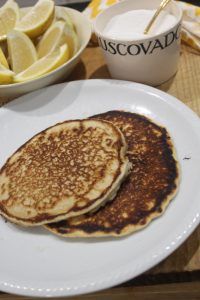

Also on the topic of food, which has been foremost in our minds all weekend, autumn vegetables are beginning to appear at the F&V shop, so Easter Sunday’s roast was accompanied by potatoes, butternut pumpkin, carrots and onions, all roasted in duck fat, plus some peas. All this roasting resulted in very good gravy.
Australia enjoys foods from many countries so we’ve eaten sushi, a traditional roast and vegetables, several Indian curries and cold meat and potato salad during the Easter season. Obviously, we also enjoyed a mountain of chocolate and hot cross buns!
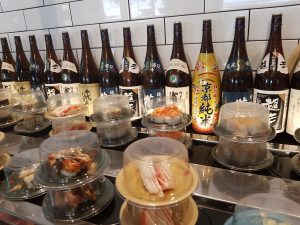

A favourite Australian food has just turned 100! I’m talking about Vegemite. First made after WW1 to replace Marmite which was in short supply, Vegemite is manufactured from brewer’s yeast. Invented by Dr Cyril P.Callister in 1923 it was not an immediate favourite but over time Vegemite became a standard spread on toast at breakfast and in school lunch boxes. Strongly flavoured, we like to offer it to visitors from overseas who seldom react enthusiastically! The trick with Vegemite is to spread it thinly. Rich in B vitamins and stable over time it is a pantry staple in Australia.
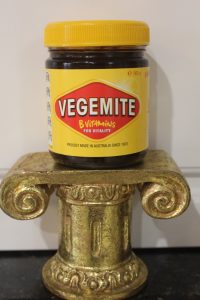

To celebrate the 100th birthday of this richly flavoured favourite, the Royal Australian Mint will release a one dollar coin featuring a jar of Vegemite.
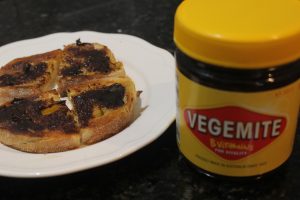

Toast and Vegemite…..delicious.
Many Australians immediately recognise the Vegemite jingle referring to Australian children as Happy Little Vegemites. Some call the jingle a second national anthem.
I remember being very cross when Vegemite replaced the iconic yellow metal screw cap in the early 90’s with a plastic lid. The jar remains an attractive jar for storing food stuffs or whatever you like after you’ve scraped it clean.( Lots of people swish hot water in the almost empty jar and pour the resulting Vegemite flavoured stock into soups or casseroles).
LITTLE JOBS
I made a barrier from cut up school rulers to protect a mosaic from constant wash during rain or when the reticulation was running. The mosaic is precious as I used chips of blue and white china found where there had once been a rubbish tip on the farm where I grew up. I collected the chips over many years as wear and tear and the weather revealed more pieces and eventually I had quite a few. I used some to make this piece. I was worried the constant water running over it would damage it.
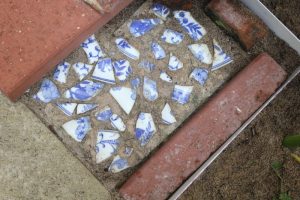

The white barrier, made from old school rulers, works really well.
Using old plastic school rulers, indicating our son’s progress through primary and secondary school ( I knew they’d be useful one day!) I chose two which were very similar in height, my son cut them to length and I glued them together to create a slightly raised barrier. When the glue was dry I pushed them in and packed sand behind the barrier to keep them securely in place. A few hours later we had very heavy rain and the barrier did its job!
Some time ago I restored a rusty, chipped and faded panel to hang on our fence. When I was working on it I realised it had once been a gate. The hinges had been cut off. I intend to grow plants against this panel. I used brackets to attach it to the wall.
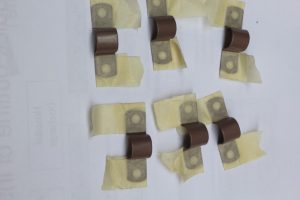

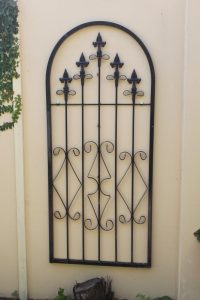

To begin, I taped over the parts of the brackets which would be screwed on the wall, knowing it would be better to paint them in situ, covering the screw heads. Sprayed the raised centre of each bracket black which would be on the panel using black spray paint inside and out.
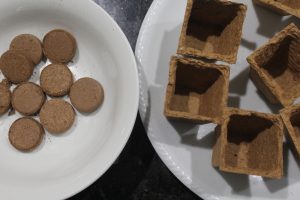

These little grow pots and soil ‘circles’ which become potting mix when wet, came from one of the supermarkets who offered plants, soil and grow pots as a reward for spending a set amount of money.
After the panel was attached to the wall I planted hollyhock seeds in little grow pots and began removing tree roots from the soil. An apricot tree had been previously espaliered to the wall. Unfortunately, the wildlife wouldn’t share the fruit with us, so, sadly, the tree was removed. I’ll plant the hollyhocks when they are ready.
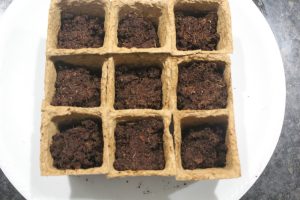

Hollyhock seeds can take ages to germinate.
I hope your Easter break was calm and enjoyable. I hope you found Easter a time to do things you like with the company you like, too.
